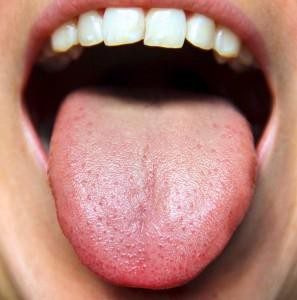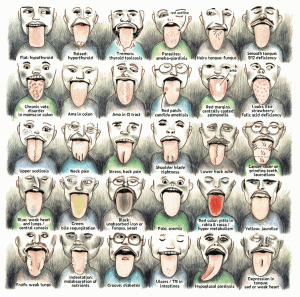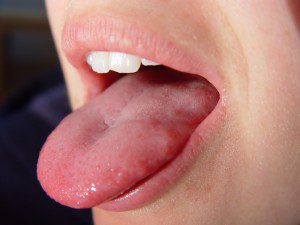By Dr. DC, CAP
Guest Writer for Wake Up World
In Ayurveda, one of the primary investigative tools of practitioners for determining the state of one’s health is tongue diagnosis or evaluation of the tongue. The tongue is the very beginning of the digestive tract, which lumbers on for another 30 feet or so. Since we cannot see much beyond the mouth without some invasive diagnostics, a quick look at the tongue can tell much about the health of your inner digestive skin.
Your inner skin is without a doubt the most important determining factor for your overall health. By inner skin, I mean the epithelium or the skin that lines the digestive tract. Let’s quickly take a look at what healthy inner digestive skin is responsible for:
[pro_ad_display_adzone id=”110028″]
1. Hosting of trillions of beneficial microbes (1)
2. Where 95% of the serotonin for mood health is derived (2)
3. Where 80% of the immune system is found (3,4)
4. The protective barrier to ward off environmental toxins (5)
5. The delivery of all vitamins, minerals and nutrients (6)
6. Regulates genetic and epigenetic changes to the human genome (7-9)
This is, of course, the extremely short list of why the health of the inner digestive skin is so important. The problem with diagnosing the inner skin is that we cannot see it – or can we? The tongue can give us quick and useful indications about the status of our digestion.
The Perfect Tongue
Before we discuss “the perfect tongue” constitutionally, note that we will all have a tongue that closely reflects our main constitution. For example:
Vata Constitution
- The tongue will tend to be thinner, smaller, and a bit rough and dry.
Pitta Constitution
- The tongue will be a bit more red in color, medium in size, and slightly dry.
Kapha Constitution
- The tongue will be larger, full, possibly light pink, and a bit wet.
Based on the normal variations between body types, a perfect tongue will be:
- Pink – not pale, scarlet, or red.
- The pinkish color would be consistent across the entire tongue.
- You would be able to see small cylindrical taste buds on the entire top surface of the tongue.
- It would be not too wet and not too dry – it would be just right!
- You would not see any cracks on the tongue.
- There would be a very thin white coating of mucus on the tongue.
- There would be no teeth marks on the sides of the tongue.
Tongue Diagnosis: Looking For Imbalances
Perhaps most directly seen on the tongue is the health of the epithelium of the stomach. After the food hits the tongue, the next stop is the stomach. Often the quality of the mucus lining of the stomach is reflected on the lining of the tongue.
Movie Star Tongue
When the tongue becomes red, smooth, and moist or wet, I call this a “movie star tongue.” While it might be pretty, it is not a functional tongue, and here is why. When there is irritation or excess acid in the stomach, the tongue will often reflect that by becoming more red. Due to the irritation of the stomach lining and perhaps the upper part of the small intestine, the taste buds will contract as if trying to hide and protect themselves from the irritation. The result is a very smooth tongue that looks like it was sanded down and buffed. Such a tongue will often be moist, which is a reflection of the excess mucus produced in the stomach and small intestine to protect the lining from the irritation.
IBS Tongue
The “irritable bowel” tongue reflects intestinal irritation from stress on the tongue. It can be smooth, wet and pale. The smoothness is because the taste buds are reacting to the stress by contracting or hiding. It is wet because of the reactive mucus production generated as a result of the stress, and its paleness is the result of the stomach eventually stopping the production of stomach acid as a way to protect the intestinal wall from further irritation.
Acid Tongue
The “acid tongue” reflects symptoms like occasional heartburn. When stomach acid builds up in the stomach and begins to move upwards, it can irritate the lining of the stomach, esophagus, mouth, and tongue. The result is a very red, dry, and often smooth tongue.
Boggy Tongue
A “boggy tongue” reflects a digestive fire that has been turned off. This typically results in a pale, wet, coated, and even swollen tongue depending on what the body type is.
Malabsorption Tongue
This tongue generally has scalloping teeth marks along the sides of the tongue. It can also be discolored, where it might be reddish in one area, pale in another, and pink somewhere else.
Stress Tongue
This tongue, which generally afflicts vata and pitta types, will have many small cracks on the tongue. This is not to be confused with a “geographic tongue,” which normally exhibits many cracks. A “stress tongue” is also typically dry and often unsteady.
Spinal Stress or CNS Stress Tongue
Sometimes you will see a deep crack running down the center of the tongue. This often reflects chronic stress in the central nervous system or spinal stress from injury.
Ama Tongue
Ama, in Ayurveda, is the accumulation of improperly digested food that can congest the intestinal tract. An “ama tongue” is when the tongue builds up a thick coating on the entire tongue. If the accumulation of ama is on the back of the tongue, it is generally a build-up of toxins in the large intestine. If it is in the middle of the tongue, it points to a build-up of toxins in the middle of the tongue.
Pale Tongue
A pale tongue suggests that there is a lack of good stomach acid and digestive enzymes needed to properly digest food and deliver the minerals, vitamins and nutrients needed for optimal health. Sometimes this can also be a sign of anemia.
Dry Tongue
For the stomach to produce the acid needed to digest hard-to-digest foods, the stomach requires proper hydration. Proper hydration supports a bicarbonate layer of cells that is 80% water and buffers the acids in the stomach. Without adequate hydration, the stomach will not produce acid and the tongue often becomes very dry and slightly pale.
Wet Tongue
A “wet tongue” can be due to excess kapha (mucus) from a severely irritated stomach lining, intestinal wall, undigested proteins like casein or gluten, or from excessive stress.
Swollen Tongue
A “swollen tongue” may suggest a congested lymphatic system backing up into the cervical lymph nodes, tonsils, adenoids, and tongue. Look for other signs of lymph congestion to confirm this.
Each of these tongue imbalances reflect a certain type of digestive imbalance. Please read the articles in my digestive health article and video archives to address your particular issue, or schedule a personalized Ayurvedic consult so we can dig in deeper.
Caring For Your Tongue
Tongue scraping is the simple practice of scraping the tongue before brushing the teeth. Studies have shown that this simple technique:
- Reduces undesirable bacteria in the mouth that compromise gum, teeth and oral health. (10)
- Reduces volatile sulfur compounds (VSC) that are by-products of mouth bacteria linked to bad breath. (11)
- Increases the function of taste buds to better taste and digest food. (12)
- Changes the environment of the mouth to reduce putrefaction and decrease bacterial load. (13)
Toxins, or ama (as we discussed earlier), collect on the back of the tongue that can cause obstructions in respiration and foul smell. (14)
Copper may be the best metal to use for tongue scraping because the mouth is loaded with both good and not-so-good bacteria. Copper not only seems to be toxic to the bad bacteria, it also provides important enzymes that are needed for the healthy microbes of the mouth to survive. (15,16)
In one study, the antiseptic benefits of copper were so great that, when copper was put in hospital rooms as furnishings, the surface bacteria count on all the surfaces in the hospital room was significantly reduced. (17) Some hospitals are now incorporating copper furnishings as part of their anti-bacterial strategies.
How To Scrape Your Tongue
- In the morning, right after you wake up, scrape your tongue. Make it the first thing you do. Even if you wake up in the middle of the night, scraping the tongue followed by a glass of water can reduce accumulating digestive ama (toxins).
- With a relaxed tongue, using your U-shaped tongue scraper, gently reach to the back of the tongue and scrape the tongue from back to front. Repeat this 5-10 times, reaching as far back as comfortable, rinsing the scraper after each pass. A slight gag can help bring up some mucus and ama from the back of the throat.
- Follow tongue scraping with brushing (with non-fluoride toothpaste), flossing, and a large glass of water.
- To complete an Ayurvedic oral hygiene routine, this can be followed by oil pulling – of course, this would require another round of tooth brushing.
- Get into the habit of scraping your tongue prior to each brushing.
How’s the health of your tongue? Take a peek!
References:
- http://www.ncbi.nlm.nih.gov/pubmed/25888704
- Gerson M. The Second Brain. Harper Collins. New York. 1998
- http://www.ncbi.nlm.nih.gov/pubmed/10564096
- http://www.ncbi.nlm.nih.gov/pmc/articles/PMC2515351/
- http://www.ncbi.nlm.nih.gov/pmc/articles/PMC3775315/
- http://www.ncbi.nlm.nih.gov/pmc/articles/PMC1378139/
- http://www.ncbi.nlm.nih.gov/pubmed/20376150
- http://www.ncbi.nlm.nih.gov/pubmed/22841660
- http://www.ncbi.nlm.nih.gov/pubmed/25785303
- http://www.ncbi.nlm.nih.gov/pubmed/16032940
- http://www.ncbi.nlm.nih.gov/pubmed/15341360
- http://www.ncbi.nlm.nih.gov/pubmed/15191584
- http://www.ncbi.nlm.nih.gov/pubmed/15191584
- Caraka Samhita. Sutrasthana. Ch 5. Verse 71-75
- http://www.ncbi.nlm.nih.gov/pubmed/22341460
- http://www.ncbi.nlm.nih.gov/pmc/articles/PMC3067274/
- http://www.ncbi.nlm.nih.gov/pubmed/22173515
About the author:
 Dr. John Douillard, DC, CAP, is a globally recognized leader in the fields of natural health, Ayurveda, and sports medicine. He is the creator of LifeSpa.com, the leading Ayurvedic health and wellness resource on the web. LifeSpa.com is evolving the way Ayurveda is understood around the world, with over 500 articles and videos proving ancient wisdom with modern science. Dr. John is the former Director of Player Development for the New Jersey Nets NBA team, author of 6 books, a repeat guest on the Dr. Oz show, and featured in Woman’s World Magazine, Huffington Post, Yoga Journal and dozens of other publications. He directs LifeSpa, the 2013 Holistic Wellness Center of the year in Boulder, CO.
Dr. John Douillard, DC, CAP, is a globally recognized leader in the fields of natural health, Ayurveda, and sports medicine. He is the creator of LifeSpa.com, the leading Ayurvedic health and wellness resource on the web. LifeSpa.com is evolving the way Ayurveda is understood around the world, with over 500 articles and videos proving ancient wisdom with modern science. Dr. John is the former Director of Player Development for the New Jersey Nets NBA team, author of 6 books, a repeat guest on the Dr. Oz show, and featured in Woman’s World Magazine, Huffington Post, Yoga Journal and dozens of other publications. He directs LifeSpa, the 2013 Holistic Wellness Center of the year in Boulder, CO.
Connect with Dr. John at his website www.lifespa.com and on www.facebook.com/dr.douillard.
[pro_ad_display_adzone id=”110027″]










